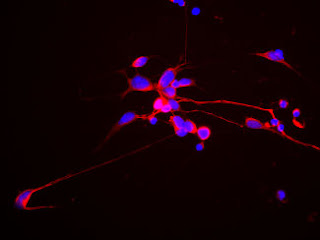Our Neural Progenitor Markers keep moving up in the "hit parade". These markers are important for lineage selection. This selection is essential to circumvent the possibility of tumor formation and facilitate the safe translation of ES-based therapies to humans.
Here's a recent pub referencing use of several of our markers for selecting or confirming lineage: J. Simon Lunn, Crystal Pacut, Emily Stern, Stacey A. Sakowski, J. Matthew Velkey, Sue O'Shea, Eva Feldman. Intraspinal transplantation of neurogenin-expressing stem cells generates spinal cord neural progenitors. dx.doi.org/10.1016/j.nbd.2011.12.044...Tuj1 (Neuromics, 1:1000), Nestin (Neuromics, 1:500)...
Highlights: Expression of appropriate transcription factors is one approach to direct the differentiation of ES cells towards a specific lineage and stop proliferation. Neural differentiation can be initiated in ES cells by expression of Neurogenin1 (Ngn1). In this study we investigate the effects of controlled Ngn1 expression on mouse ES (mES) cell differentiation in vitro and following grafting into the rat spinal cord. In vitro, Ngn1 expression in mES cells leads to rapid and specific neural differentiation, and a concurrent decrease in proliferation. Similarly transplantation of Ngn1-expressing mES cells into the spinal cord lead to in situ differentiation and spinal precursor formation. These data demonstrate that Ngn1 expression in mES cells is sufficient promote neural differentiation and inhibit proliferation, thus establishing an approach to safely graft ES cells into the spinal cord.
Image: Neural progenitors were labeled with anti-rat Nestin polyclonal antibody (Cat#:GT15114) and stained with conjugated donkey anti-goat secondary anti-body (green). Differentiated neurons were labeled with neuron-specific mouse anti-β-III tubulin/ Tuj1-(Cat#MO15013 monoclonal antibody (red). Nuclei were stained with DAPI (blue).
I will continue to post updates on the application of Neuromics' Stem Cell Markers
Scientists grow retina cells from skin-derived stem cells
-
WASHINGTON - University of Wisconsin-Madison researchers have successfully
grown multiple types of retina cells from two types of stem cells, giving
new ho...
15 years ago










